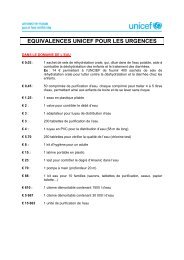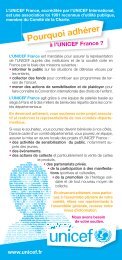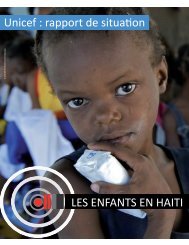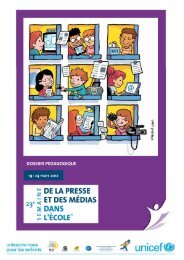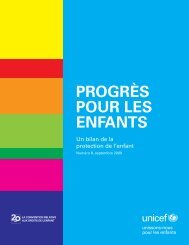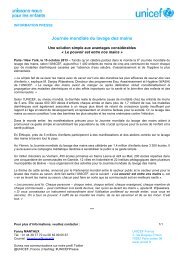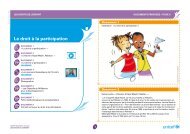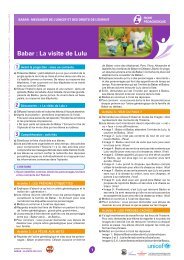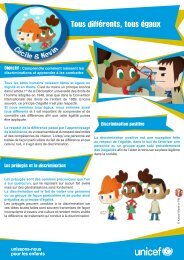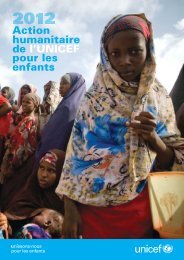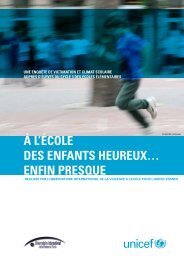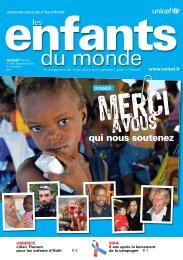RéférencesCHAPITRE 11 Estimations de l’UNICEF fondées sur <strong>le</strong>s travauxdu Groupe interinstitutions pour l’estimation de lamortalité de l’enfant.2 Organisation mondia<strong>le</strong> de la Santé et Fonds <strong>des</strong>Nations Unies pour l’enfance, ‘Integration ofVitamin A Supp<strong>le</strong>mentation with Immunization:Policy and programme implications, Rapport <strong>des</strong>éance (OMS/EPI/GEN/98.07)’ OMS, Genève,1998, pp. 4-12.3 Darmstadt, Gary L., et al., ‘Evidence-Based, Cost-Effective Interventions: How many newbornbabies can we save?’, The <strong>La</strong>ncet, vol. 365, no.9463, 12 mars 2005, pp. 977-988.4 Phillips, James F., Ayaga A. Bawah et Fred N.Binka, ‘Acce<strong>le</strong>rating Reproductive and Child HealthProgramme Impact with Community-BasedServices: The Navrongo experiment in Ghana’,Bul<strong>le</strong>tin de l’Organisation mondia<strong>le</strong> de la Santé,vol. 84, no. 12, déc. 2006, pp. 949-953.5 Fonds <strong>des</strong> Nations Unies pour l’enfance, Progrèspour <strong>le</strong>s <strong>enfants</strong> : Un <strong>monde</strong> digne <strong>des</strong> <strong>enfants</strong>bilan statistique, Numéro 6, UNICEF, New York,déc. 2007, p. 19.6 OMS, Bureau régional pour l’Afrique, The Healthof the Peop<strong>le</strong>: The African regional health report,OMS Press, Genève, 2006, p. 19.7 Newell, Marie-Louise, et al., ‘Mortality of Infectedand Uninfected Infants Born to HIV-InfectedMothers in Africa: A poo<strong>le</strong>d analysis’, The <strong>La</strong>ncet,vol. 364, no. 9441, 2 oct. 2004, pp. 1236-1243.8 De Cock, Kevin M., et al., ‘Prevention of Motherto-ChildHIV Transmission in Resource-PoorCountries: Translating research into policy andpractice’, Journal of the American MedicalAssociation, vol. 283, no. 9, 1 mars 2000,pp. 1175-1182.9 Organisation mondia<strong>le</strong> de la Santé, Programmecommun <strong>des</strong> Nations Unies sur <strong>le</strong> VIH/SIDA etFonds <strong>des</strong> Nations Unies pour l’enfance, Vers unaccès universel : étendre <strong>le</strong>s interventions prioritairesliées au VIH/SIDA <strong>dans</strong> <strong>le</strong> secteur de la santé –Rapport de <strong>situation</strong>, avril 2007, OMS, Genève,2007, pp. 6, 30.10 Ngongo, Ngashi, ‘PMTCT Report Card 2005:Monitoring progress on the imp<strong>le</strong>mentation of programsto prevent mother to child transmission ofHIV’, UNICEF, New York, p. 5.11 Fonds <strong>des</strong> Nations Unies pour l’enfance, Progrèspour <strong>le</strong>s <strong>enfants</strong> : Un <strong>monde</strong> digne <strong>des</strong> <strong>enfants</strong>,bilan statistique, Numéro 6, UNICEF, New York,déc. 2007, p. 36.12 Fonds <strong>des</strong> Nations Unies pour l’enfance et <strong>le</strong>Partenariat faire recu<strong>le</strong>r <strong>le</strong> paludisme, ‘Malaria &Children: Progress in intervention coverage’,UNICEF et RBM, New York, 2007, pp. 1, 7.13 Fonds mondial de lutte contre <strong>le</strong> VIH/SIDA, latuberculose et <strong>le</strong> paludisme : Bilan et impact <strong>des</strong>trois maladies, Genève, 2005, p. 39.14 Fonds <strong>des</strong> Nations Unies pour l’enfance, Progrèspour <strong>le</strong>s <strong>enfants</strong> : Un <strong>monde</strong> digne <strong>des</strong> <strong>enfants</strong>bilan statistique, Numéro 6, UNICEF, New York,déc. 2007, pp. 39-41.15 Organisation mondia<strong>le</strong> de la Santé, ‘Situation sanitaire: Mortalité’, Statistiques sanitaires mondia<strong>le</strong>s2006, OMS, Genève, 2007, pp. 29-31.16 Fonds <strong>des</strong> Nations Unies pour l’enfance, Progrèspour <strong>le</strong>s <strong>enfants</strong> : Un bilan de l’eau et de l’assainissement,Numéro 5, UNICEF, New York, sept.2006, p. 3.17 Black, Robert E., Saul S. Morris et Jennifer Bryce,‘Where and Why Are 10 Million Children DyingEvery Year?’, The <strong>La</strong>ncet, vol. 361, no. 9376, 28juin 2003, p. 2230.18 Organisation mondia<strong>le</strong> de la Santé, ‘ImprovingChild Health in the Community’, OMS, Genève,déc. 2002, p. 7.19 Compte à rebours jusqu’en 2015 : suivre <strong>le</strong>s progrèsen faveur de la survie de l’enfant : rapport2005, UNICEF, Section de la santé, New York,2005, p. 9.20 Estimations de l’UNICEF fondées sur <strong>le</strong>s travauxdu Groupe interinstitutions pour l’estimation de lamortalité de l’enfant.21 Darmstadt, Gary L., et al., ‘Evidence-Based, Cost-Effective Interventions: How many lives of newbornbabies can we save?’, The <strong>La</strong>ncet,, 3 mars 2005, p. 11.22 Organisation mondia<strong>le</strong> de la Santé, Making aDifference in Countries: Strategic approach toimproving maternal and newborn survival andhealth, OMS, Genève, 2006, p. 9.23 ‘Tab<strong>le</strong>au 1. Indicateurs de base, pp. 114-117 duprésent rapport.24 Pinheiro, Paulo Sérgio, Etude du Secrétaire général<strong>des</strong> Nations-Unies sur la vio<strong>le</strong>nce contre <strong>le</strong>s<strong>enfants</strong>, New York, 2006, p. 51.25 Fonds <strong>des</strong> Nations Unies pour l’enfance, ‘EarlyMarriage: Child spouses’, Innocenti Digest, no. 7,UNICEF Centre de recherche Innocenti, Florence,mars 2001, p. 11.26 Ibid.27 Ibid.28 Fonds <strong>des</strong> Nations Unies pour l’enfance, The‘Rights’ Start to Life: A statistical analysis of birthregistration, UNICEF, New York, 2005, pp. 1, 13.29 Organisation <strong>des</strong> Nations Unies pour l’éducation,la science et la culture, Rapport mondial de suivisur l’EPT 2007 : Un bon départ : éducation et protectionde la petite enfance, UNESCO, Paris,2006, p. 2.30 Porterfield, Shir<strong>le</strong>y L., et Timothy D. McBride, ‘TheEffect of Poverty and Caregiver Education onPerceived Need and Access to Health Servicesamong Children with Special Health Care Needs’,American Journal of Public Health, vol. 97, no. 2,févr. 2007, p. 323.31 Ibid.32 White, Howard, Maintaining Momentum to 2015?An impact evaluation of interventions to improvematernal and child health and nutrition inBangla<strong>des</strong>h, Banque mondia<strong>le</strong>, Washington, D.C.,sept. 2005, p. 25.33 Fonds <strong>des</strong> Nations Unies pour l’enfance, <strong>La</strong>Situation <strong>des</strong> <strong>enfants</strong> <strong>dans</strong> <strong>le</strong> <strong>monde</strong> 2006 : excluset invisib<strong>le</strong>s, UNICEF, New York, déc. 2005, p. 18.34 Victora, Cesar G., et al., ‘Applying an Equity Lensto Child Health and Mortality: More of the same isnot enough’, The <strong>La</strong>ncet, vol. 362, no. 9379, 19juil<strong>le</strong>t 2003, p. 234.35 Ibid.ENCADRÉS DU CHAPITRE 1Le taux de mortalité <strong>des</strong> moins de 5 ans :indicateur indispensab<strong>le</strong> de la santé <strong>des</strong> <strong>enfants</strong>Fonds <strong>des</strong> Nations Unies pour l’enfance, <strong>La</strong> <strong>situation</strong><strong>des</strong> <strong>enfants</strong> <strong>dans</strong> <strong>le</strong> <strong>monde</strong> 2007: Femmes et<strong>enfants</strong> – Le doub<strong>le</strong> dividende de l’égalité <strong>des</strong> sexes,UNICEF, New York, déc. 2006, pp. 137, 141.Causes sous-jacentes et structurel<strong>le</strong>s de lamortalité maternel<strong>le</strong> et infanti<strong>le</strong>Fonds <strong>des</strong> Nations Unies pour l’enfance, ‘Stratégiecommune de l’UNICEF concernant la santé et lanutrition (2006-2015) (E/ICEF/2006/8)’, Nations Unies,Conseil économique et social, New York, 15 nov.2005, pp. 3-4.Survie <strong>des</strong> nouveau-nésDarmstadt, Gary L., ‘Evidence-Based, Cost-EffectiveInterventions: How many newborn babies can wesave?’, The <strong>La</strong>ncet, vol. 365, no. 9463, 12 mars 2005,pp. 977-988; The <strong>La</strong>ncet Series Team, ‘ExecutiveSummary of The <strong>La</strong>ncet Neonatal Survival Series’,The <strong>La</strong>ncet, 3 mars 2005, p. 1; <strong>La</strong>wn, Joy E., SimonCousens et Jelka Zupan, ‘4 Million Neonatal Deaths:When? Where? Why?’, The <strong>La</strong>ncet, 5 mars 2005, vol.365, no. 9462, pp. 891-900; Save the Children, Stateof the World’s Mothers 2006: Saving the lives ofmothers and newborns, Save the Children, Westport,CT, mai 2006, pp. 3, 8; ‘Tab<strong>le</strong>au 8. Les femmes’, pp.142-145 du présent rapport ; Organisation mondia<strong>le</strong>de la Santé, Rapport sur la santé <strong>dans</strong> <strong>le</strong> <strong>monde</strong>,2005 - donnons sa chance à chaque mère et à chaqueenfant, OMS, Genève, 2005, pp. 9-10.Les principa<strong>le</strong>s causes immédiates <strong>des</strong> décèsd’<strong>enfants</strong>Mulholland, Kim, ‘Childhood Pneumonia Mortality: Apermanent global emergency’, The <strong>La</strong>ncet, vol. 370,no. 9583, 21 juil<strong>le</strong>t 2007, pp. 285-289; Fonds <strong>des</strong>Nations Unies pour l’enfance, Progrès pour <strong>le</strong>s<strong>enfants</strong> : Un bilan de l’eau et de l’assainissement,Numéro 5, UNICEF, New York, sept. 2006, p. 2, etProgrès pour <strong>le</strong>s <strong>enfants</strong>: Un <strong>monde</strong> digne <strong>des</strong><strong>enfants</strong>, bilan statistique, Numéro 6, déc. 2007, pp.19, 24; UNICEF et Organisation mondia<strong>le</strong> de la Santé,Pneumonia: The forgotten kil<strong>le</strong>r of children, UNICEFet OMS, New York et Genève, 2006, p. 5.<strong>La</strong> pneumonie de l’enfant : un fléau oubliéMulholland, Kim, ‘Childhood Pneumonia Mortality: Apermanent global emergency’, The <strong>La</strong>ncet, vol. 370,no. 9583, 21 juil<strong>le</strong>t 2007, pp. 285-289; Sazawal, Sunil,et Robert E. Black, ‘Effect of Pneumonia CaseManagement on Mortality in Neonates, Infants, andPreschool Children: A meta-analysis of communitybasedtrials’, The <strong>La</strong>ncet Infectious Diseases, vol. 3,no. 9, sept. 2003, pp. 547-556; Fonds <strong>des</strong> NationsUnies pour l’enfance et Organisation mondia<strong>le</strong> de laSanté, <strong>La</strong> pneumonie de l’enfant : un fléau oublié,UNICEF et OMS, New York, et Genève, 2006, p. 5, 7-9, 14, 26, 27; Organisation mondia<strong>le</strong> de la Santé,‘Evidence Base for the Community Management ofPneumonia (WHO/FCH/CAH/02.23)’, OMS Dépt.Santé et développement <strong>des</strong> <strong>enfants</strong> et <strong>des</strong> ado<strong>le</strong>scents,Stockholm, juin 2002, pp. 2, 5-6.Le continuum <strong>des</strong> soins de santé pour la mère, <strong>le</strong>nouveau-né et l’enfant <strong>dans</strong> l’espace temporel etgéographique<strong>La</strong>wn, Joy, et Kate Kerber, editors, Opportunitiesfor Africa’s Newborns: Practical data, policy andprogrammatic support for newborn care in Africa,Partenariat pour la santé de la mère, du nouveau-néet de l’enfant, Genève, 2006, p. 3, 5, 9, 24; Le Galès-Camus, Catherine, ‘Stratégie commune de l’UNICEFconcernant la santé et la nutrition (2006-2015), déclarationà la première session ordinaire du Conseil d’administration,New York, 17 janv. 2006, pp. 3-4; Fonds<strong>des</strong> Nations Unies pour l’enfance, Stratégie communede l’UNICEF concernant la santé et la nutrition(2006-2015) (E/ICEF/ 2006/8), Nations Unies, Conseiléconomique et social, New York, 15 nov. 2005, p. 3.104 LA SITUATION DES ENFANTS DANS LE MONDE <strong>2008</strong>
<strong>La</strong> santé de l’enfant <strong>dans</strong> <strong>des</strong> <strong>situation</strong>s d’urgencecomp<strong>le</strong>xesCIEDRS Working Group, ‘Building the Evidence Baseon the Provision of Health Care to Children inComp<strong>le</strong>x Emergencies, Draft 4.0’, Center forInternational Emergency, Disaster and RefugeeStudies, Johns Hopkins Bloomberg School of PublicHealth, Baltimore, MD, sept. 2003, pp. 3-4, 11, 14-15; Collins, Steve, ‘Community-Based TherapeuticCare: A new paradigm for se<strong>le</strong>ctive feeding in nutritionalcrises – Network paper no. 48’, HumanitarianPractice Network, Overseas Development Institute,Londres, nov. 2004, p. 24; Collins, Steve, et. al., ‘KeyIssues in the Success of Community-BasedManagement of Severe Malnutrition’, Food andNutrition Bul<strong>le</strong>tin, vol. 27, no. 3 (suppl.), sept. 2006,p. 58; Équipe 4 du Projet Objectifs du Millénaire surla santé maternel<strong>le</strong> et infanti<strong>le</strong>, Who’s Got thePower? Transforming health systems for women andchildren, Earthscan, Londres, 2005, p. 77;Organisation mondia<strong>le</strong> de la Santé, Guide to HealthWork-Force Development in Post-ConflictEnvironments, OMS, Genève, 2005, p. 2.Donner <strong>des</strong> moyens d’action aux femmes pourpromouvoir la santé de la mère, du nouveau-né etde l’enfantPerry, Henry, et al., ‘Barriers to Immunization amongWomen and Children in Slums of Zone 3 of DhakaCity, Bangla<strong>des</strong>h: A qualitative assessment’,International Centre for Diarrhoeal Disease Research,Dhaka, avril 2007, pp. 16-19; Seidel, Renata, BehaviorChange Perspectives and Communication Guidelineson Six Child Survival Interventions, Academy forEducational Development et Johns HopkinsBloomberg School of Public Health, Washington,D.C., déc. 2005, p. 20; Équipe 4 du Projet Objectifsdu Millénaire sur la santé maternel<strong>le</strong> et infanti<strong>le</strong>,Who’s Got the Power? Transforming health systemsfor women and children, Earthscan, Londres, 2005, p.36; OMS Centre pour <strong>le</strong> développement de la santé,‘A Toolkit for Women’s Empowerment andLeadership in Health and Welfare’, Kobe, Japon,2005, pp. 26-28; Organisation mondia<strong>le</strong> de la Santé,‘Women’s Health in Afghanistan’, OMS Dépt. Genreet santé de la femme, Family and Community HealthCluster, Genève, mars 2002, pp. 1-2.L’enregistrement <strong>des</strong> naissances : un pas importantvers <strong>le</strong>s services essentiels‘Tab<strong>le</strong>au 9. Protection de l’enfant’, pp. 146-147 duprésent rapport; UNICEF Centre de rechercheInnocenti, ‘Birth Registration and Armed Conflict’,Innocenti Insight, UNICEF IRC, Florence, 2005, p. vii;Fonds <strong>des</strong> Nations Unies pour l’enfance, ‘BirthRegistration’, Child Protection Information Sheets,UNICEF, New York, mai 2007, pp. 13-14; Fonds <strong>des</strong>Nations Unies pour l’enfance, Progrès pour <strong>le</strong>s<strong>enfants</strong> : Un <strong>monde</strong> digne <strong>des</strong> <strong>enfants</strong>, bilan statistique,Numéro 6, UNICEF, New York, déc. 2007, p. 42,et The ‘Rights’ Start to Life: A statistical analysis ofbirth registration, 2005, pp. 2, 15-16.CHAPITRE 21 Lee, Ronald, ‘The Demographic Transition: Threecenturies of fundamental change’, Journal ofEconomic Perspectives, vol. 17, no. 4, 2003, pp.167-190.2 Van Lerberghe, Wim, et Vincent De Brouwere, ‘OfBlind Al<strong>le</strong>ys and Things that Have Worked:History’s <strong>le</strong>ssons on reducing maternal mortality’,Safe Motherhood Strategies: A review of the evidence,publié par Wim Van Lerberghe et VincentDe Brouwere, Studies in Health ServicesOrganisation & Policy, vol. 17, 2001, pp. 7-34.3 Claeson, Mariam, et Ronald J. Waldman, ‘TheEvolution of Child Health Programmes inDeveloping Countries: From targeting diseases totargeting peop<strong>le</strong>’, Bul<strong>le</strong>tin de l’Organisation mondia<strong>le</strong>de la Santé, vol. 78, no. 10, 2000, p. 1235;Oliveira-Cruz, Va<strong>le</strong>ria, Christoph Kurowski et AnneMills, ‘Delivery of Priority Health Services:Searching for synergies within the vertical versushorizontal debate’, Journal of InternationalDevelopment, vol. 15, 2003, p. 68; et Fonds <strong>des</strong>Nations Unies pour l’enfance, 1946-2006: Soixanteans au service <strong>des</strong> <strong>enfants</strong>, UNICEF, New York,2006, pp. 7-9.4 Mills, Anne, Fawzia Rasheed et Stephen Tollman,‘Strengthening Health Systems’, Chapitre 3,Disease Control Priorities in Developing Countries,2nd ed., publié par Dean T. Jamison, et al., OxfordUniversity Press et Banque mondia<strong>le</strong>, Washington,D.C., 2006, p. 88.5 Green, Andrew, An Introduction to Health Planningin Developing Countries, 2nd ed., OxfordUniversity Press, New York, 1999; et Mor<strong>le</strong>y,David, ‘Under-Five Clinics’, Medical Care inDeveloping Countries: A primer on the medicine ofpoverty and a symposium from Makerere, publiépar Maurice H. King, Oxford University Press, NewYork, 1966.6 Basch, Paul F., Textbook of International Health,2nd ed., Oxford University Press, New York, juil<strong>le</strong>t1999.7 Thieren, Michel, ‘Background Paper on the Conceptof Universal Access’, réunion technique sur l’élaborationd’un cadre pour parvenir à un accès universelà la prévention, au traitement et aux soins duVIH/SIDA <strong>dans</strong> <strong>le</strong> secteur de la santé, OMS,Genève, oct. 2005; et Vaccine Safety DatalinkGroup, ‘The Use of a Computerized Database toMonitor Vaccine Safety in Viet Nam’, Bul<strong>le</strong>tin del’Organisation mondia<strong>le</strong> de la Santé, vol. 83, no. 8,août. 2005, p. 605.8 Knippenberg, Rudolf, et al., ‘Imp<strong>le</strong>mentation of theBamako Initiative: Strategies in Benin and Guinea’,The International Journal of Health Planning andManagement, vol. 12, no. S1, 12 juin 1997, pp.S29-S47.9 Walsh, J. A., et K. S. Warren, ‘Se<strong>le</strong>ctive PrimaryHealth Care: An interim strategy for diseasecontrol in developing countries’, New EnglandJournal of Medicine, vol. 301, no. 18, 1 er nov.1979, pp. 967-974.10 Ibid.11 Ibid.11 Claeson, Mariam, et Ronald J. Waldman, ‘TheEvolution of Child Health Programmes inDeveloping Countries: From targeting diseases totargeting peop<strong>le</strong>’, Bul<strong>le</strong>tin de l’Organisation mondia<strong>le</strong>de la Santé, vol. 78, no. 10, 2000, p. 1235.12 Ibid.13 Black, Maggie, ‘Children First: The story of UNI-CEF, past and present’, Oxford University Press,New York, 1996, p. 19.14 Claeson, Mariam, et Ronald J. Waldman, ‘TheEvolution of Child Health Programmes inDeveloping Countries: From targeting diseases totargeting peop<strong>le</strong>’, Bul<strong>le</strong>tin de l’Organisation mondia<strong>le</strong>de la Santé, vol. 78, no. 10, 2000, p. 1235.15 UNICEF Statistics, ‘Integrated Management ofChildhood Illness: An initiative for effective casemanagement’, UNICEF End Decade Databases:IMCI, , consulté <strong>le</strong>15 nov. 2007.16 Organisation mondia<strong>le</strong> de la Santé et UNICEF,‘Management of Childhood Illness in DevelopingCountries: Rationa<strong>le</strong> for an integrated strategy’,IMCI Information (OMS/CHS/CAH/98.1A Rev. 1),OMS, Genève, 1999, p. 3.17 Bryce, Jennifer, et al., ‘The Multi-CountryEvaluation of the Integrated Management ofChildhood Illness Strategy: Lessons for the evaluationof public health interventions’, AmericanJournal of Public Health, vol. 94, no. 3, mars 2004,pp. 406-415; Lucas, Jane E., et al., Imp<strong>le</strong>mentingthe Household and Community Component ofIMCI in the Eastern and Southern Africa Region(ESAR): A state-of-the art review of the humanrights-basedapproach to programming in thecontext of acce<strong>le</strong>rated child survival, UNICEF NewYork et UNICEF ESARO, 2005, p. xii.18 Victora, Cesar G., et al., ‘Integrated Managementof the Sick Child’, Chapitre 63, Disease ControlPriorities in Developing Countries, 2nd ed., publiépar Dean T. Jamison, et al., Oxford UniversityPress et Banque mondia<strong>le</strong>, Washington, D.C.,2006, p. 1189.19 Armstrong Schel<strong>le</strong>nberg, Joanna R. M., et al.,‘Effectiveness and Cost of Facility-BasedIntegrated Management of Childhood Illness(IMCI) in Tanzania’, The <strong>La</strong>ncet, vol. 364, no. 9445,30 oct. 2004, p. 1583.20 Lucas, Jane E., et al., Imp<strong>le</strong>menting theHousehold and Community Component of IMCI inthe Eastern and Southern Africa Region (ESAR): Astate-of-the art review of the human-rights-basedapproach to programming in the context of acce<strong>le</strong>ratedchild survival, UNICEF New York et UNICEFESARO, 2005, p. 86.21 Victora, Cesar G., et al., ‘Integrated Managementof the Sick Child’, Chapitre 63, Disease ControlPriorities in Developing Countries, 2nd ed., publiépar Dean T. Jamison, et al., Oxford UniversityPress et Banque mondia<strong>le</strong>, Washington, D.C.,2006, pp. 1188-1189.22 Martines, Jose, et al., ’Neonatal Survival: A call foraction’, The <strong>La</strong>ncet, vol. 365, no. 9465, 26 mars2005, p. 1191.23 Chen, Shaohua, et Martin Ravallion, ‘AbsolutePoverty Measures for the Developing World, 1981-2004’, Groupe de recherche sur <strong>le</strong> développement,Banque mondia<strong>le</strong>, Washington, D.C., mars 2007,p. 12.24 Bryce, Jennifer, et al., ‘Countdown to 2015:Tracking intervention coverage for child survival’,The <strong>La</strong>ncet, vol. 368, no. 9541, 23 sept. 2006, pp.1070-1071.25 Jones, Gareth, et al., ‘How Many Child DeathsCan We Prevent this Year?’, The <strong>La</strong>ncet, vol. 362,no. 9377, 5 juil<strong>le</strong>t 2003, p. 65; et <strong>La</strong>wn, Joy E., etal., ‘Newborn Survival’, Chapitre 27, DiseaseControl Priorities in Developing Countries, 2nd ed.,publié par Dean T. Jamison, et al., OxfordUniversity Press et Banque mondia<strong>le</strong>, Washington,D.C., 2006, p. 547.26 Campbell, Oona M. R., et Wendy J. Graham,‘Strategies for Reducing Maternal Mortality:Getting on with what works’, The <strong>La</strong>ncet, vol. 368,no. 9543, 28 sept. 2006, p. 1297.27 Hill, Ze<strong>le</strong>e, Betty Kirkwood et Karen Edmond,Family and Community Practices that PromoteChild Survival, Growth and Development: A reviewof the evidence, Organisation mondia<strong>le</strong> de laSanté, Genève, 2004, p. 1.28 Wagstaff, Adam, et al., ‘Mil<strong>le</strong>nnium DevelopmentGoals for Health: What will it take to acce<strong>le</strong>rateprogress?’, Chapitre 9, Disease Control Priorities inDeveloping Countries, 2nd ed., publié par Dean T.Jamison, et al., Oxford University Press et Banquemondia<strong>le</strong>, Washington, D.C., 2006, pp. 181-194.ENCADRÉS DU CHAPITRE 2L’Initiative de lutte contre la rougeo<strong>le</strong>Fonds <strong>des</strong> Nations Unies pour l’enfance, Un <strong>monde</strong>digne <strong>des</strong> <strong>enfants</strong>, UNICEF, New York, 2006, p. 29;Wolfson, <strong>La</strong>ra J., et al., ‘Has the 2005 Meas<strong>le</strong>sMortality Reduction Goal Been Achieved?: A naturalhistory modelling study’, The <strong>La</strong>ncet, vol. 369, no.9557, 20 janv. 2007, pp. 191-192; Organisation mondia<strong>le</strong>de la Santé, ‘Cinquante-Sixième Assemblée mondia<strong>le</strong>de la Santé, Résolution 52.20: Réduction de lamortalité par rougeo<strong>le</strong> <strong>dans</strong> <strong>le</strong> <strong>monde</strong>, OMS, Genève,28 mai 2003; Organisation mondia<strong>le</strong> de la Santé etFonds <strong>des</strong> Nations Unies pour l’enfance, Rougeo<strong>le</strong> :Réduction de la mortalité et élimination régiona<strong>le</strong>. Planstratégique 2001-2005, OMS, Genève, 2001, pp. 6-7.RÉFÉRENCES 105
- Page 1:
LA SITUATION DES ENFANTS DANS LE MO
- Page 5 and 6:
Avant-proposEn 2006, pour la premi
- Page 7 and 8:
LA SITUATION DES ENFANTS DANS LE MO
- Page 9 and 10:
LA SITUATION DES ENFANTS DANS LE MO
- Page 11 and 12:
socioculturels plus complexes que n
- Page 13 and 14:
Figure 1.3Interventions simples, à
- Page 15 and 16:
Depuis 1990, plusieurs régions ont
- Page 17 and 18:
ils sont nettement insuffisants dan
- Page 19 and 20:
chaque année avant la date butoir
- Page 21 and 22:
la réanimation éventuelle des nou
- Page 23 and 24:
par les MTI s’élargit rapidement
- Page 25 and 26:
Le continuum des soins de santé po
- Page 27 and 28:
de moins de 5 ans par an et les pay
- Page 29 and 30:
© UNICEF/HQ06-2640/Tom PietrasikQu
- Page 31 and 32:
Les mariages forcés sont une forme
- Page 33 and 34:
4 (définis ici comme étant des pe
- Page 35 and 36:
LA SITUATION DES ENFANTS DANS LE MO
- Page 37 and 38:
(anciennement Ting Hsien), à envir
- Page 39 and 40:
d’approche de « zone desservie
- Page 41 and 42:
de Bamako allait devenir le moteurd
- Page 43 and 44:
Prise en charge intégrée des mala
- Page 45 and 46:
n’avaient pas profité des progr
- Page 47 and 48:
Figure 2.4Cadre conceptuel pour att
- Page 49 and 50:
prestation et l’utilisation des s
- Page 51 and 52:
Le Partenariat pour la santé des m
- Page 53 and 54:
LA SITUATION DES ENFANTS DANS LE MO
- Page 55 and 56:
Les pratiques fondamentales des int
- Page 57 and 58:
des associations féminines. Ces gr
- Page 59 and 60:
quate et un soutien des pairs; desp
- Page 61 and 62: ne sont pas appropriés et que lesl
- Page 63 and 64: © UNICEF/HQ06-1855/Josh EsteyLes c
- Page 65 and 66: onne raison d’établir une collab
- Page 67 and 68: PleinsfeuxLe Mozambique : un progra
- Page 69 and 70: Les enfants d’âge scolaire sont
- Page 71 and 72: LA SITUATION DES ENFANTS DANS LE MO
- Page 73 and 74: maladies, nous devons rassembler de
- Page 75 and 76: Grâce à cette vaste mobilisation
- Page 77 and 78: nombreuses interventions qui requi
- Page 79 and 80: Exemples d’analyses de goulets d
- Page 81 and 82: © UNICEF/ HQ03-0459/Shehzad Nooran
- Page 83 and 84: la saison humide. En outre, le faib
- Page 85 and 86: des OMD liés à la santé n’avan
- Page 87 and 88: Au cours de la phase trois, on esti
- Page 89 and 90: pays - surtout en ce qui concernel
- Page 91 and 92: Renforcer la transparence et la gou
- Page 93 and 94: aient aussi se servir d’indicateu
- Page 95 and 96: • La création d’un réseau acc
- Page 97 and 98: trices de sel où l’idée de paye
- Page 99 and 100: Troisièmement, nous élaborons et/
- Page 101 and 102: En raison de la rapidité avec laqu
- Page 103 and 104: LA SITUATION DES ENFANTS DANS LE MO
- Page 105 and 106: pendant la grossesse, à la naissan
- Page 107 and 108: nouveau-nés et des mères ; et les
- Page 109 and 110: mortalité des moins de cinq ans -
- Page 111: nus à considérablement réduire l
- Page 115 and 116: Mulligan, ‘General Primary Care
- Page 117 and 118: TABLEAUX STATISTIQUESStatistiques
- Page 119 and 120: RévisionsPlusieurs tableaux statis
- Page 121 and 122: Classement des pays et territoires
- Page 123 and 124: …TABLEAU 1Classementselon leTMM5T
- Page 125 and 126: …TABLEAU 1Classementselon leTMM5T
- Page 127 and 128: …TABLEAU 2% denouveau-nésprésen
- Page 129 and 130: % denouveau-nésprésentant uneinsu
- Page 131 and 132: …TABLEAU 3% de la populationutili
- Page 133 and 134: % de la populationutilisant dessour
- Page 135 and 136: …TABLEAU 4Estimationdu taux depr
- Page 137 and 138: …TABLEAU 4Estimationdu taux depr
- Page 139 and 140: …TABLEAU 5Tauxd’alphabétisatio
- Page 141 and 142: …TABLEAU 5Tauxd’alphabétisatio
- Page 143 and 144: …TABLEAU 6Population(milliers)200
- Page 145 and 146: …TABLEAU 6Population(milliers)200
- Page 147 and 148: …TABLEAU 7RNB parhabitant($EU)200
- Page 149 and 150: …TABLEAU 7RNB parhabitant($EU)200
- Page 151 and 152: Espérance de viedes femmes en %de
- Page 153 and 154: Espérance de viedes femmes en %de
- Page 155 and 156: …TABLEAU 9totaltotal totalParagua
- Page 157 and 158: Mesurer le développement humainInt
- Page 159 and 160: …TABLEAU 10Classementselon leTMM5
- Page 161 and 162: …TABLEAU 10Classementselon leTMM5
- Page 163 and 164:
Bureaux de l’UNICEFSiège de l’



